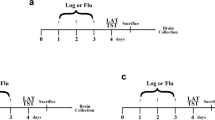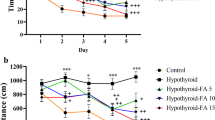Abstract
Hypothyroidism causes somatic, psychosocial and affective psychosis, including depression-like behaviors. In this study, (hypothyroidism group; HP group) adult male Sprague Dawley (SD) rats were induced to hypothyroidism after 5 weeks of exposure to 0.05% propylthiouracil (PTU) in potable water, control animals (CON group) were given the same amount of water. The following behavioral experiments were conducted, respectively: open-field test (OFT), forced swimming test (FST), tail suspension test (TST). TT\(_{3}\) and TT\(_{4}\) levels were measured after the behavior tests and the expression levels of 5-HT\(_{2A}\) receptor and 5-HT\(_{2A}\) receptor proteins were analyzed in the hippocampus and prefrontal cortex. The level of TT\(_{3}\) and TT\(_{4}\) in the HP group rats was much lower than that in the CON group. The hypothyroid rats also showed weight loss, much longer immobility time in tail suspension test and forced swimming test. Besides, 5 weeks of PTU administration was associated with significantly decreased expression levels of 5-HT\(_{2A}\) receptor and 5-HT\(_{2A}\) receptor proteins compared with control group, which were significantly negatively correlated with immobility time in FST and TST. In conclusion, our results suggest that hypothyroidism induces depressive behaviors through the influence of the serotonin system, and the decreased expression of the 5-HT\(_{2A}\) receptor is an important cause of the depressive behaviors in hypothyroidism.






Similar content being viewed by others
Availability of data and material
All data generated in this study are included in this paper.
References
Abdi H, Amouzegar A, Azizi F (2019) Antithyroid drugs. Iran J Pharm Res 18:1–12
Adongo D, Kukuia K, Mante P, Ameyaw E, Woode E (2015) Antidepressant-like effect of the leaves of pseudospondias microcarpa in mice: evidence for the involvement of the serotoninergic system, NMDA receptor complex, and nitric oxide pathway. BioMed Res Int 2015:1–15
Akaike M, Kato N, Ohno H, Kobayashi T (1991) Hyperactivity and spatial maze learning impairment of adult rats with temporary neonatal hypothyroidism. Neurotoxicol Teratol 13(3):317–322
Albert F, Santana N, Castañé A, Cortés R, María C (2013) Acute 5-ht1a autoreceptor knockdown increases antidepressant responses and serotonin release in stressful conditions. Psychopharmacology 225(1):61–74
Anton S, Tatiana V, Elena A, Dmitry V, Nina K, Vladimir S (2020) The chronic treatment with 5-HT2AÂ receptor agonists affects the behavior and the BDNF system in mice. Neurochem Res 45(12):3059–3075
Biver F, Wikler D, Lotstra F, Damhaut P, Goldman S, Mendlewicz J (1997) Serotonin 5-HT2 receptor imaging in major depression: focal changes in orbito-insular cortex. Brit J Psychiatry 171:444–448
Bortolotto VC, Pinheiro FC, Araujo SM, Poetini MR, Bertolazi BS, de Paula MT, Meichtry LB, de Almeida FP, de Freitas CS, Jesse CR, Prigol M (2018) Chrysin reverses the depressive-like behavior induced by hypothyroidism in female mice by regulating hippocampal serotonin and dopamine. Eur J Pharmacol 822:78–84
Brosvic GM, Hoey NE (1990) Taste detection and discrimination performance of rats following selective desalivation. Physiol Behav 48(5):617–623
Castagné V, Moser P, Roux S, Porsolt RD (2011) Rodent models of depression: forced swim and tail suspension behavioral despair tests in rats and mice. Curr Protoc Neurosci 55(1):8–10 (A (1–4))
Dayan CM, Panicker V (2013) Hypothyroidism and depression. Eur Thyroid J 2(3):168–179
Constant EL, de Volder AG, Ivanoiu A, Bol A, Labar D, Seghers A, Cosnard G, Melin J, Daumerie C (2001) Cerebral blood flow and glucose metabolism in hypothyroidism: a positron emission tomography study. J Clin Endocrinol Metab 86(8):3864–3870
Correia J, Ravasco P (2014) Weight changes in Portuguese patients with depression: which factors are involved? Nutr J 13(1):117
Darbra S, Garau A, Balada F, Sala J, Martí-Carbonell MA (2003) Perinatal hypothyroidism effects on neuromotor competence, novelty-directed exploratory and anxiety-related behaviour and learning in rats. Behav Brain Res 143(2):209–215
Donato F, de Gomes MG, Goes AT, Seus N, Alves D, Jesse CR, Savegnago L (2013) Involvement of the dopaminergic and serotonergic systems in the antidepressant-like effect caused by 4-phenyl-1-(phenylselanylmethyl)-1,2,3-triazole. Life Sci 93(9–11):393–400
Fischer S, Ehlert U (2018) Hypothalamic-pituitary-thyroid (HPT) axis functioning in anxiety disorders. A systematic review. Depress Anxiety 35(1):98–110
Ge JF, Peng YY, Qi CC, Chen FH, Zhou JN (2014) Depression-like behavior in subclinical hypothyroidism rat induced by hemi-thyroid electrocauterization. Endocrine 45(3):430–438
Ghenimi N, Alfos S, Redonnet A, Higueret P, Pallet V, Enderlin V (2010) Adult-onset hypothyroidism induces the amyloidogenic pathway of amyloid precursor protein processing in the rat hippocampus. J Neuroendocrinol 22(8):951–959
Gómez E, Catalán R, Navinés R, Gastó C (2001) Serotonin receptor changes in depression: evidences and limitations. Actas Espanolas de Psiquiatria 29(3):186–194
Kulikov AV, Jeanningro R (2001) The effects of hypothyroidism on 5-HT1A and 5-HT2A receptors and the serotonin transporter protein in the rat brain. Neurosci Behav Physiol 31(4):445–449
Kulikov A, Moreau X, Jeanningros R (1999) Effects of experimental hypothyroidism on 5-HT1A, 5-HT2A receptors, 5-HT uptake sites and tryptophan hydroxylase activity in mature rat brain. Neuroendocrinology 69(6):453–459
Lafaille F, Welner SA, Suranyi-Cadotte BE (1991) Regulation of serotonin type 2 (5-HT2) and beta-adrenergic receptors in rat cerebral cortex following novel and classical antidepressant treatment. J Psychiatry Neurosci 16(4):209–214
Lene VLÂ, Nídiaea FJ (2020) Effects of a single dose of psilocybin on behaviour, brain 5-HT2AÂ receptor occupancy and gene expression in the pig. Eur Neuropsychopharmacol. https://doi.org/10.1016/j.euroneuro.2020.11.013
Liang Y, Yang X, Zhang X, Duan H, Jin M, Sun Y, Yuan H, Li J, Qi Y, Qiao W (2016) Antidepressant-like effect of the saponins part of ethanol extract from SHF. J Ethnopharmacol 191:307–314
Odagaki Y, Kinoshita M, Meana J, Callado L, García-Sevilla J (2020) 5-HT2A receptor-mediated G\(\alpha\) activation in psychiatric disorders: a postmortem study. World J Biol Psychiatry. https://doi.org/10.1080/15622975.2020.1839967
Piosik PA, Groenigen MV, Baas F (1996) Effect of thyroid hormone deficiency on RC3/neurogranin mRNA expression in the prenatal and adult caprine brain. Brain Res Mol Brain Res 42(2):227–235
Porsolt RD, Le Pichon M, Jalfre M (1977) Depression: a new animal model sensitive to antidepressant treatments. Nature 266(5604):730–732
Racagni G, Popoli M (2010) The pharmacological properties of antidepressants. Int Clin Psychopharmacol 25(3):117
Rivlin RS, Osnos M, Rosenthal S, Henkin RI (1977) Abnormalities in taste preference in hypothyroid rats. Am J Physiol 232(1):80–84
Ruiz-Marcos A, Sánchez-Toscano F, Escobar F, Rey D, Escobar GMD (1980) Reversible morphological alterations of cortical neurons in juvenile and adult hypothyroidism in the rat. Brain Res 185(1):91–102
Salazar P, Cisternas P, Codocedo JF, Inestrosa NC (2017) Induction of hypothyroidism during early postnatal stages triggers a decrease in cognitive performance by decreasing hippocampal synaptic plasticity. Biochimica et Biophysica Acta 4:870–883
Sapronov N, Fedotova Y (2002) The effect of l-tryptophan on conditioned reflflex learning and behavior in rats with experimental pathology ofthe thyroid gland. Neurosci Behav Physiol 32(3):237–241
Tayde P, Bhagwat N, Sharma P, Sharma B, Dalwadi P, Sonawane A, Subramanyam A, Chadha M, Varthakavi P (2017) Hypothyroidism and depression: are cytokines the link? Indian J Endocrinol Metab 21(6):886–892
Underwood MD, Kassir SA, Bakalian MJ, Galfalvy H, Dwork AJ, Mann JJ, Arango V (2018) Serotonin receptors and suicide, major depression, alcohol use disorder and reported early life adversity. Transl Psychiatry 8(1):279
Wang Y, Zhong J, Wei W, Gong J, Dong J, Yu F, Wang Y, Chen J (2011) Developmental iodine deficiency and hypothyroidism impair neural development, upregulate caveolin-1, and downregulate synaptotagmin-1 in the rat cerebellum. Biol Trace Element Res 144(1):1039–1049
Wilcoxon J, Nadolski G, Samarut J, Chassande O, Redei E (2006) Behavioral inhibition and impaired spatial learning and memory in hypothyroid mice lacking thyroid hormone receptor alpha. Behav Brain Res 177(1):109–116
Willins DL, Deutch AY, Roth BL (1997) Serotonin 5-HT2A receptors are expressed on pyramidal cells and interneurons in the rat cortex. Synapse 27(1):79–82
Yu J, Tang YY, Feng HB, Cheng XX (2014) A behavioral and micro positron emission tomography imaging study in a rat model of hypothyroidism. Behav Brain Res 271:228–233
Zhang Q, Feng JJ, Yang S, Liu XF, Li JC, Zhao H (2016) Lateral habenula as a link between thyroid and serotoninergic system modiates depressive symptoms in hypothyroidism rats. Brain Res Bull 124:198–205
Funding
This work was supported by the the Nature Science Foundation of Liaoning Province of China (No. 2019-ZD-0620).
Author information
Authors and Affiliations
Contributions
ZCJ, JEL, PPN, FZ and YZW performed in the experiments. ZCJ and JEL analyzed the data and wrote the manuscript. JY and MZH revised the manuscript. All authors read and approved the final manuscript.
Corresponding authors
Ethics declarations
Conflict of interest
The authors declare that there are no conflicts of interest.
Additional information
Communicated by Sreedharan Sajikumar.
Publisher's Note
Springer Nature remains neutral with regard to jurisdictional claims in published maps and institutional affiliations.
Rights and permissions
About this article
Cite this article
Jin, Z., Ling, J., Yu, J. et al. Serotonin 2A receptor function and depression-like behavior in rats model of hypothyroidism. Exp Brain Res 239, 2435–2444 (2021). https://doi.org/10.1007/s00221-021-06129-1
Received:
Accepted:
Published:
Issue Date:
DOI: https://doi.org/10.1007/s00221-021-06129-1




